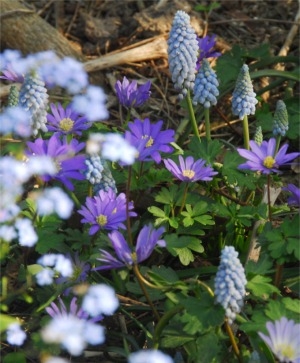 Anemone blanda Horticultural Tips
Anemone blanda Horticultural Tips
Native to Greece circa 1898, Anemone blanda yields happy little daisy-like flowers with yellow centers on wiry stems above fern-like foliage. Commonly known as Grecian Windflowers, they are available in blue, pink, white or in a mixture of the three. Deer- and rodent-resistant, Anemone blanda makes an attractive 4" to 5" tall ground cover in border plantings or as an underplanting beneath contrasting Hyacinths, Tulips or Narcissi. Anemone blanda are also lovely mixed with select varieties of Muscari and other special, miscellaneous bulbs in naturalizing drifts. They are much loved by bees, butterflies and helpful pollinators.
Anemone blanda are good naturalizers. As Anemone blanda matures over time, when it’s happy where it’s planted, it naturalizes by bulb offsets (called bulbils: baby bulbs on the sides of the mother bulb you’ve planted). It’s terrific in garden borders, sunny woodland borders and in irregular river-like swaths.
Heirloom Anemone blanda
If you are looking for heirloom flower bulbs, you will be happy to know that two of our selections qualify.
1854 Anemone blanda Blue Shades
1854 Anemone blanda White Splendour
Horticultural Zone Hardiness
Anemone blanda are good for horticultural zones 5 through 9. If your garden is in a horticultural zone that is either too cold or only marginally appropriate, you may want to apply no more than a 2" layer of mulch after the ground surface freezes in the fall. The mulch should trap the cool temperatures into the soil, not warmth. Mulch helps to protect the bulbs from arctic temperature spikes. Good mulching mediums include straw, salt marsh hay or oak leaves. In the spring, you can loosen the mulch in the area in which the Anemone blanda will be sprouting.
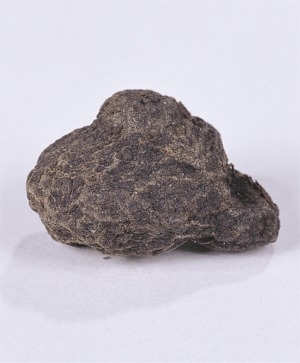 Bulb Inspection
Bulb Inspection
Check your shipment against the packing slip and make sure that everything is as it should be. Occasionally, bags of smaller bulbs may be placed in the inner boxes of other bulbs to reduce jostling during shipment. If you can’t find something, open all of the inner boxes. If there is a discrepancy, please call us immediately so that we may resolve it with you. Since every bag or box of bulbs in your order has been scanned using its UPC barcode, we can usually tell you exactly in which box each variety is located.
Inspect your bulbs carefully. We make every effort to ship you only healthy, firm, top quality bulbs.
Anemone blanda "bulbs" look different from other types of flower bulbs like Tulips or Narcissi. These "bulbs" are actually corms that look like black, irregularly-shaped, wizened little pellets. If the soil is dry at planting time, you can give them a head start by soaking them no longer than eight hours in room temperature water.
It is natural for some types of bulbs to develop a transportation mold when they are exposed to oxygen. It is a natural gray-blue-green mold that occurs when they are exposed to air, and that disappears as soon as the bulbs are planted. The soil naturally wicks it away. If you prefer, you may spread the bulbs out in the sun, or brush it off with a paper towel although it is not necessary.
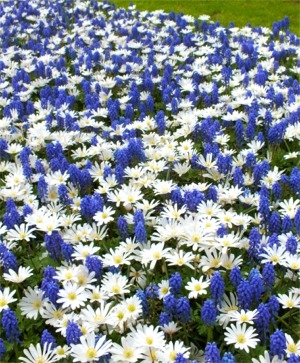 Little cuts, scars, discolored exteriors and dimples are normal marks from the flower bulb harvesting, cleaning and sizing processes in the Netherlands. Anemone blanda corms do not have a papery skin or sheath. The most important factor is the way that the corm feels. As long as the corm is firm, it is a good and viable corm.
Little cuts, scars, discolored exteriors and dimples are normal marks from the flower bulb harvesting, cleaning and sizing processes in the Netherlands. Anemone blanda corms do not have a papery skin or sheath. The most important factor is the way that the corm feels. As long as the corm is firm, it is a good and viable corm.
Bulb Size
Top size Anemone blanda corms are 5 cm/up. You might find several Anemone blanda corms that are larger than the others. This is the "up" part of the Anemone blanda corm size. Each of the corms is, at a minimum, at least 5 cm. They are sized on conveyor belts in the Netherlands that have holes the centimeter size just below the top size measurement. Smaller bulbs fall through these holes and are not included in our stock. All of the larger corms are included in our stock, and, as a result, there can be size variation. (If any variety in any season produces a smaller top size bulb than expected, we note it on our website. If a price change occurs as a result, we post the new price and make an adjustment on every order.)
Bulb Storage Before Planting
After you’ve received your order and inspected it, keep the exterior carton and the inner boxes open to give the bulbs some air. All bulbs love good air circulation. Store them in a cool, dry place with low humidity, away from heat, frost and strong sunlight at about 50°F to 70°F. Never put flower bulbs in the freezer! Poor storage conditions could cause bulbs to dry out, or to become moldy.
 Select and Prepare the Planting Site
Select and Prepare the Planting Site
Anemone blanda prefers to be planted in organically rich, well-draining, neutral pH soil in full to partial sunlight.
The best soil is a sandy loam. For clay soil, break up the clay about a foot deeper than the planting depth of your bulbs and amend the bed with sand, peat moss and/or well-aged, neutral pH compost. For excessively sandy soil, amend the bed with peat moss, aged leaf compost and/or well-aged, neutral pH compost.
Please do not ever add horse manure, chicken droppings, mushroom compost, other hot manure or immature compost to your flower bulb beds. If you would like to add compost you’ve made yourself, please make sure that it is completely decomposed, healthy and neutral pH. Partially decomposed compost can spread fungal disease, such as botrytis blight, and nasty pests. What is good for vegetables is not necessarily good for flower bulbs.
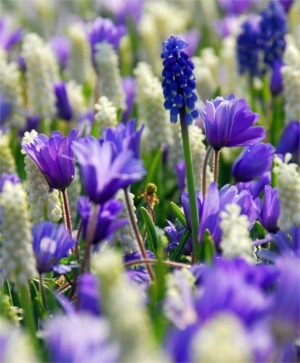 Easy to Plant
Easy to Plant
Anemone blanda corms are so easy to plant. We'll ship you the corms in time for planting in your garden in the fall, once the ground has chilled down to about 55°F, after about two weeks of sweater weather when night time temperatures have hovered in the 40s. This is the best time to plant. Flower bulbs and corms do everything in response to temperature and sunlight. If they are planted too early, before the ground has chilled down to around 55°F, they may grow unnecessary top growth, which could diminish their vitality in spring. If they are planted too late, all-important root system growth could be hampered. Immature, underdeveloped root systems could result in more foliage than flowers. Not good.
Plant these little corms 4" deep and 3" to 4" apart. Please do not put anything in the bottom of hole that you’ve dug for the corms. Even if you think it is good for the corms, it could cause root burn. Nestle the corm into its hole, and please don’t worry about which side is up, and which side is down. Top growth will grow toward the surface of the soil. Fill and cover the hole with soil to the level of the bed, and tamp down the soil lightly, making sure that individual holes are no longer apparent and that the garden bed surface is level. This will help to prevent water from filling up any of the individual planting holes. All flower bulbs hate to get wet feet.
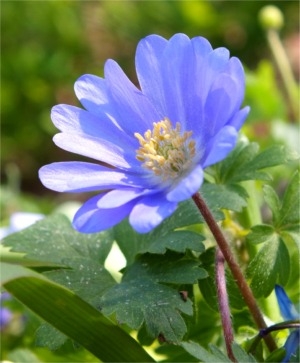 You’ll need about nine bulbs per square foot. (Square footage is determined multiplying the planting site’s length times its width.)
You’ll need about nine bulbs per square foot. (Square footage is determined multiplying the planting site’s length times its width.)
Fertilizing
Never put anything, including fertilizer, in the bottom of each bulb planting hole. To do so is to run the risk of root burn. Plant the bulbs to the proper depth and spacing, tamp down the soil and broadcast a 5-10-5 or 4-10-6 granular organic fertilizer over the surface of the bed as if you were feeding the birds.
While all flower bulbs are nature’s perfect little packages and will bloom beautifully the first year, we recommend broadcasting fertilizer three times a year for all perennial and naturalizing flower bulbs. First at the time of fall planting to help grow the roots, second when the sprouts emerge in the spring to help nourish the foliage and flower, and finally, when the flowers start to die back to help feed the bulb itself. Bone meal is incomplete nutritionally and can attract animals to some varieties of bulbs (like Crocus or Tulips).
Do Not Plant Anemone blanda in Exterior Containers or Raised Beds
Flower bulbs should never be planted in outdoor containers, window boxes or raised beds where bulbs experience temperature spiking and repeated cycles of freezing and thawing. This results in root growth failure, root system destruction, frozen bulbs and/or bulb rot from poor water drainage. Flower bulbs must have a consistent cold winter temperature with good water drainage in order to produce a mature root system that will permit foliage growth and flower production in the spring.
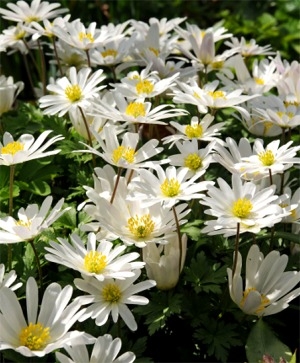 Bloom Times, Size and Color
Bloom Times, Size and Color
The bloom time listed for each variety is for horticultural zone 5 in normal spring conditions. The warmer the horticultural zone, the earlier flower bulbs will bloom. The colder the horticultural zone, the later flower bulbs will bloom in the spring.
Flower bulbs do everything in response to temperature, sunlight and site conditions. Bloom times, heights and colors are approximations affected by temperature and site conditions regardless of the calendar date. If it is a warm spring, bulbs will bloom earlier. If it is a cold spring, bulbs will bloom later. If it is a long cool spring, followed by rapid warming, you may find odd bedfellows: earlier blooming Galanthus flowering right along side later blooming Crocus, Species Tulips and Narcissi. Each spring can offer a different sort of garden surprise party.
In the event of a mild winter or a warmer-than-usual spring, flower bulbs that have emergent stalks with set buds may bloom early, small and short, although they will likely grow taller and larger as temperatures moderate. Temperature spikes can also affect mature root development, the actual form of the flower or the process of flower color maturation.
Spring Care
Once Anemone blanda bloom and start to die back in the spring, make sure to keep the foliage going until it dies back naturally. A maximum period of photosynthesis allows the bulbs to regenerate for the future. Once the foliage is completely yellowed or browned out, remove it from the garden.
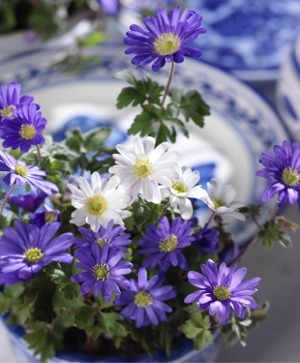 Forcing
Forcing
Anemone blanda are also good for forcing indoors over the winter. Pot them up in mid-October and precool them at a consistent, dark 38°F to 45°F for six to eight weeks with moderate watering. At the end of the precooling period, bring the pots out of refrigeration into progressively stronger sunlight with moderate watering. They usually bloom around four weeks later. Once Anemone blanda bulbs are forced, their vitality is spent and the bulbs may be discarded.
Trouble Shooting
If Anemone blanda start to yield more foliage than flowers, it normally indicates a root system issue. A mature planting may need to be dug up in the fall, and transplanted to the original depth and spacing after carefully separating the bulbs that may have been strangling themselves. Sometimes, frost heaving causes the little corms to be pushed up above the 4" planting depth. If this happens, the corms could be more susceptible to winter temperature spiking. If you notice this happening, you may want to carefully dig them up in the fall and replant them to the proper depth.




